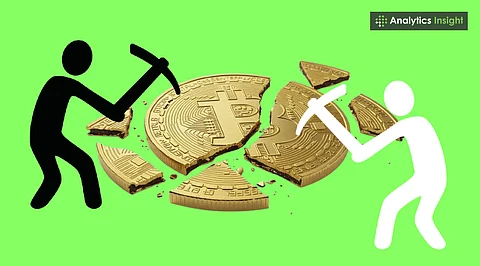

Bitcoin Mining: It both verifies transactions and releases new bitcoins into circulation, making it essential to the network’s trustless design.
Halving Events Shape Industry: The April 2024 halving reduced rewards to 3.125 BTC per block, increasing competition and pushing miners toward efficiency.
Energy and Hardware Demands Rise: Modern mining requires specialized ASIC machines, large amounts of electricity, and often benefits from renewable energy.
Bitcoin mining is the process by which new bitcoins are created, transactions are verified, and added to the public ledger known as the blockchain. It serves two main purposes: securing the Bitcoin network against fraud and bringing new coins into circulation.
Bitcoin is a digital currency that's not controlled by a central bank or a company. It's based on thousands of independent computers, known as 'nodes,' distributed all over the globe. Some nodes are 'miners.'
Miners employ powerful computers to solve complex mathematical equations based on cryptographic algorithms. These mathematical problems form part of Bitcoin's proof-of-work system. According to this system, new transactions are added to the blockchain with considerable computational effort.
Whenever a miner finds an answer to a puzzle, he constructs a 'block' with a list of new transactions. The block is then appended to the blockchain, and the transactions become permanent and untamperable. As a reward, the miner gets a fixed amount of newly issued bitcoins along with transaction fees.
The miners received 50 bitcoins per block when BTC started in 2009. This prize cuts roughly every four years in what's called the Bitcoin halving. In April 2024, the fourth halving cut the prize from 6.25 bitcoins to 3.125 bitcoins per block. Halving is programmed into the coin's code to prevent inflation and guarantee only 21 million bitcoins will ever be created. The next halving will be around 2028, reducing rewards again to 1.5625 bitcoins per block.
Also Read: When Is the Next Bitcoin Halving and Why Does it Matter?
Early on, miners were able to use ordinary desktop computers. With increased competition, miners moved on to more powerful graphics cards (GPUs) and eventually to purpose-built hardware referred to as ASICs (Application-Specific Integrated Circuits). ASICs are purely for mining. ASICs are much more efficient but costlier and power-hungrier.
Bitcoin changes its 'difficulty' level about every two weeks. Difficulty is a measure of how difficult it is to find a valid block. When there are more miners joining the network and blocks are found too readily, difficulty goes up; when miners leave the network, difficulty goes down. This helps maintain the block times constant at approximately 10 minutes.
Bitcoin Mining consumes enormous amounts of electricity since ASICs need to operate 24/7 to compete. This has raised issues regarding BTC’s environmental footprint. Some mining operations use renewable power sources such as hydroelectric, wind, or solar to lower their carbon footprint. Others, however, prefer areas that have plenty of cheap power. There are disagreements over whether or not BTC's energy consumption is justified by its utility, including financial decentralization and censorship resistance.
Solo mining today is uncommon. It's highly unlikely that any one miner will find a block without tremendous computational power. Instead, most are part of mining pools, where members pool their processing and share rewards in proportion. This makes payouts more regular for miners, but it centralizes some elements of the network.
Mining is the foundation of Bitcoin. It prevents double-spending, maintains the integrity of transactions, and provides an economic incentive for stakeholders to keep the network up. Without miners, Bitcoin would be at risk of attack and would not be possible as a trustless system.
Also Read: Bitcoin’s Value Evolution: If 10,000 BTC Could Buy Pizza, What Can It Buy Now?
As time passes, with rewards shrinking, miners will increasingly rely on transaction fees for revenue. That may spur changes like the Bitcoin network and mining economics. Hardware efficiency improvements, the use of renewable energy, and regulatory shifts will also define the industry.
As of now, mining is both a competitive business and a central cornerstone of Bitcoin's decentralized architecture. Whether you regard it as revolutionary genius or an expensive squandering of resources, there can be no question that Bitcoin mining is essential to the life of the cryptocurrency.
1. What hardware do I need for Bitcoin mining?
To mine Bitcoin profitably in 2025, you need an ASIC (Application-Specific Integrated Circuit) miner. Popular models include Bitmain’s Antminer series and MicroBT’s WhatsMiner. You’ll also require a stable internet connection, a compatible mining pool account, and an efficient cooling setup to prevent overheating during continuous 24/7 operation.
2. How long does it take to mine $1 of Bitcoin?
The time depends on your mining hardware, electricity costs, and Bitcoin’s market price. In 2025, with an average ASIC and standard pool participation, it can take several hours to a day to mine $1 worth of BTC. However, high electricity costs can erase these earnings, making location and efficiency critical.
3. Is BTC mining legal in India?
Yes, Bitcoin mining is legal in India as of 2025, but it operates in a gray regulatory space. There’s no official ban, but miners must comply with electricity usage laws, pay applicable taxes, and follow anti-money laundering (AML) guidelines. The government may introduce specific crypto regulations in the future.
4. Can a normal PC mine Bitcoin?
Technically yes, but it’s not profitable. In Bitcoin’s early years, regular PCs could mine effectively, but today’s difficulty level requires powerful ASIC miners. A standard PC would take years to mine a fraction of a bitcoin and consume more in electricity costs than the BTC earned.
5. What is a Bitcoin mining pool and why join one?
A mining pool is a group of miners who combine their computing power to increase the chances of finding a block. Rewards are split based on contribution. Joining a pool provides more consistent payouts than solo mining, making it the preferred choice for most miners in 2025.
